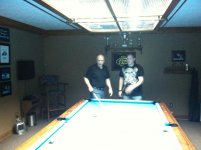Sounds like what I do naturally. And if this is CTE PRO ONE why would anyone need 2 dvds to explain it? I am being honest with that question.
Because some people don't do what you do naturally and they don't get it with the simple explanation.
I used to sell jump cues. When I decided to make and sell them I decided that I would need to be able to demonstrate them effectively. So I practiced in my shop until I developed a lot of shots. My goal was to show how effective this cue could be in game situations. I was successful and developed a great show that made it very clear what was possible with a jump cue and practice. My job was done right?
No. Not at all.
Because what I found out was that while people could see what I was doing, while they could listen to my pitch, they could not use the cue properly.
And at first I was lost as to how to help them. To me it was easy to use a jump cue because I had practiced so much with it and when I first started I wasn't great with it. So the answer was easy, buy it and go practice. But that is not how it works because at a show people want to make it work right there before parting with their cash.
So I had to learn to teach this "simple" act. And the problems ranged from wrong perceptions to really bad mechanics. Sometimes I had to trick the person psychologically into completing the stroke and other times I had to rebuild a person's stroke. I had at least ten different approaches to help the player understand the mechanics of using a jump cue. I did thousands of lessons over a four year period, sometimes with as many as four people on the table at once.
When you have a concept as foreign to "conventional" by-the-book aiming as CTE is then it's a great mental hurdle, especially for the lower level players. I have noticed that really good players "see" it much easier. For the B and C level players though this is not an easy concept to explain in words or even capture on video.
And without someone there to observe the player's form how can the distant instructor know what the proper approach is to help the player understand the concept?
As to why one would need a second or third or fourth dvd to teach a concept that's easy....teaching is easier when you have done more of it. I spent a lot of time refining my approach to explaining how to jump balls and my methods were hugely more effective in the second year I was doing it. By the third year it was nothing for me to teach anyone to jump in less than five minutes, and I mean ANYONE regardless of their skill level. This ability developed through lots of experience with the subject and with hundreds of students.
Anytime someone does a first version of anything they almost immediately see where they could have done it better after it's shipped. That's just the way it is, rarely is anything perfect the first time.
Why don't you flip the question and ask yourself what it is about CTE that a man would devote so much time and effort and endure relentless ridicule, endure criminal defamation, and intense criticism to create a DVD teaching it?
It ain't for the money.

